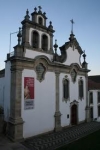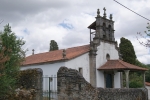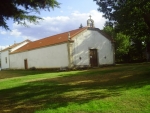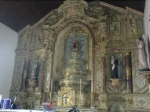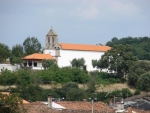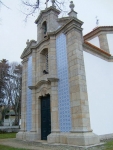DirectoryENG
The Convent of Balsamão has a part reserved for guests – House Retreat and Rest of Balsamão with central heating, 37 rooms with private bathroom, lounge andsatellite TV, conference room meetings or seminars, restaurant, bar and party hall for weddings, baptisms and
other gatherings.
The retreat house and rest of the Convent of Balsamão, as the name implies, is intended to spiritual retreats, courses, seminars, or simply relaxing a vacation away from the hustle of big cities.
People who are Hosted in the Convent may participate in the prayers of the religious community, if they so wish.
Balsamão!
Silence that speaks, refreshing breezes, warm heat, wind that shakes, perfume inebriates, bringing faith, hope it inspires, ignites charity, peace that passes, God who reveals himself!
Vieux of Oranges-trees cloister.
The Convent of Balsamão is located in the north-east, Trás-os-Montes, in the heart of Bragança county, at 57 km from the city, 17 km away from Macedo de Cavaleiros and 4 km from the village of Chacim. The Balsamão hill is watered by river Azibo, in the south, with a small roman bridge lain across, and by the stream of Chacim in the north.
As high as 522 m, the small hill has very particular micro-climate that allows the growth of the orange-tree and the almond-tree, making the landscape astonishing when the bloom starts.
Party hall for weddings.
Facing it you find the Bornes Mountain, once called “honey hill” with its fertile valleys and hillocks. The visitor, among other touristic points, has the chance to see the roman bridges mentioned before, the village of Malta, once a property of the military order with the same name, which is closely connected to the history of Balsamão, the damming of Azibo with
its magnificent fluvial beach.
The Balsamão hill is an isolated place where you can enjoy the beauty of the nature and the silence.
The Historic memory of the convent is compose by the church( sanctuary of our lady of Balsamão), a small and old cloister and the room of the honour-able Frey Casimiro that conquers the tourists by its meaning, beauty and simplicity.
In the Convent lives a religious community, the Marians of the Immaculate Conception who owns the Convent. They offer a shelter for pilgrims and guests. It also develops an activity plan linked to religious matters and studies for religious life and priesthood.
The retreat house at Convento de Balsamão has 37 rooms – all equipped with telephone, restrooms and heating – social and TV rooms, library, museum, conference rooms, cafeteria, restaurant, ballroom, a chapel and a church that has just undertaken a comprehensive restoration.
Activities: Guided tour of the convent including museum, cloisters, chapel and church. All marked hiking trails around the property. Guided visit to the famous beach at the Azibo River, tours to the cities of Macedo de Cavaleiros, Alfândega da Fé, Bragança, Miranda do Douro, Santiago de Compostela in Spain and others.
Services and comforts:
[one_third]
- Breakfast
- Free Wi-Fi
- 24 Hours a day
- Lunch and dinner
- 24 Hour front desk
[/one_third]
[one_third]
- Banquets
- Parking free
- Outside the convent
- Weddings and christenings
- Restaurant and coffee bar
[/one_third]
[one_third]
- Portuguese
- English
- Spanish
- French
[/one_third]
Descripción: the building attached to the church of São Francisco of great architectural value, continued by the church of our Lady Nossa Senhora da Encarnação. Here you can to see a vast artistic patrimony, related with popular religion.
Opening hours: Wednesday to Saturday – 10am to 5pm, (Opened on holidays: 9:30am to 1pm and 2.30pm to 6pm)
Date: 14th century (conjectural) / Modern Age
Description: Mannerist church with a rectangular plan, with a rectangular porch. It has a single nave. All elevations are covered by a basement and cornice with wedges topped by spires. The interior space has walls plastered and painted blue. The choir has wooden balustrades and stairs on the Epistle Side. You can see four side chapels of perfect arches, the access to the choir and the churchyard and the holy water font.
State of Conservation: good.
Source: Património dos Concelhos da Terra Fria Concelho de Bragança VOLUME II
Dating: it may have been built or rebuilt in 1757.
Description: access to this large temple is done by a wide staircase. In the churchyard there is a church garden sink of holy water from the ruined Chapel of Santa Eulalia, where is said to have existed in the town of Medea. In the grand facade stands out the high Bell Tower of three records. Inside there are 9 altars carved polychrome; a pulpit; the baptistery of granite and the high altar with the national arms.
State of conservation: good.
Legends and Traditions: a house in the Fountain of the Moor Street, in the neighborhood of Pereiro, the memory remains the site of the old parish church. It is a stone with the date 1622. The main religious festivals of this village are from São Sebastião (on the 3rd Sunday of January), St. Apolinário (the last Sunday in July) and Nossa senhora da Assunção (15th of August). Here also conducts a biweekly (Wednesday) fair (8 and 26 of each month) and an annual fair (December 8).
Source: Património dos Concelhos da Terra Fria Concelho de Bragança VOLUME II
Date: 18th century (conjectural).
Description: this site as well the sanctuary, consists of eight entrances representing the Calvary, is also the source of “Engaranhos” with some imperceptible inscriptions.
State of conservation: reasonable.
Legends and traditions: the people believe that the source of the “Engaranhos” has the power to cure people suffering from problems of growth, speech and locomotion. In May 1932, the Abade de Baçal discovered several prehistoric inscriptions on a rock near the fountain of 2Engaranhos”, belonging quite possibly to a roman castro. They also say that in Serapicos are hidden treasures and enchanted Moorish women. The pilgrimage of Nossa Senhora do Aviso is celebrated on the first Sunday of June.
Location: Serapicos, Bragança
Source: Património dos Concelhos da Terra Fria Concelho de Bragança VOLUME II
Dating: Church of medieval roots, rebuilt in the late 18th century.
Description: the entrance may be earlier than the reconstruction of the Church, in the late 18th century. The inside features a ship of plain walls. In the background, on the side of the Gospel, is the baptismal Chapel and further arise the north side access door and two Windows. On the side of the Epistle is the pulpit with a railing of carved rocaille, which accesses by stairs located in the sacristy. The chancel, of rectangular plan has granite slabs on the ground, two Windows, and walls covered with lime.
State of Conservation: good.
Location: Parada, Bragança
Source: Património dos Concelhos da Terra Fria Concelho de Bragança VOLUME II
Dating: 16th century (1509).
Description: Chapel of small proportions. In the chancel are kept some ex-votes of wood with polychrome.
State of conservation: good.
Location: Grijó de Parada, Bragança
Source: Património dos Concelhos da Terra Fria Concelho de Bragança VOLUME II
Date: the primitive church would be medieval, possibly of the 13th or 14th century, of which only the Romanesque vestibule is conserved.
Description: the rugged-looking and quite narrow facade had a porch. It has a perfect back arch portal with three archivolts. The BellTower, built of plastered masonry, will be the result of an 18th-century addition. The lateral portal, located on the side of the Epistle, has a triangular pediment which houses an image of the Patron Saint, St. Mary Magdalene and features an inscription. The interior of one ship, the soil is coated the granite slabs and decoration boils down to two altarpieces of carved Baroque that flank the transept and a pulpit, platform and granite staircase.
State of Conservation: good
Legends and traditions: in Grijó de Parada there is a hill called ModorraTower, where they took the stones for the reconstruction of the Church. It is possibly a castro or a defensive stronghold.
Source: Património dos Concelhos da Terra Fria Concelho de Bragança VOLUME II
Date: for some authors the church is of the 16th century.
Description: the church has the main entrance covered by a portch, inside of which you find a sink of rock. For this church a set of boards, discovered for the priest Francisco Videira Pires that represent scenes of the life and death of Christ as the Quo Vadis, the meditation of St. Peter, the women saints next to Christ on the Cross and the punishment of St. Peter.
State of Conservation: reasonable
Location: São Pedro de Sarracenos, Bragança
Source: Património dos Concelhos da Terra Fria Concelho de Bragança VOLUME II
Date: Modern Age (the primitive church would be of century XV).
Description: the facade is coated with modern tiles. The vestibule is decorated with sheled form, which opens to a grand window. The interior altars are of polychromatic woodwork.
State of consertation: good
Legends and Traditions: the pilgrimage Senhor de Cabeça Boa occurs in the 1st Sunday of May. Certain day, a Portuguese emigrant in Brazil was lost at sea and asked for the aid the Saint Christ, promising to build a temple to it if he was saved. Thus the chapel of Saint Christ was born, where the arrival of the Christianity to lands of Vera Cruz is celebrated. Other story says that in the darkest night, the lamp suspended in the chapel is sighted in the distant mountain ranges.
Location: Samil, Bragança
Source: Património dos Concelhos da Terra Fria Concelho de Bragança VOLUME II


